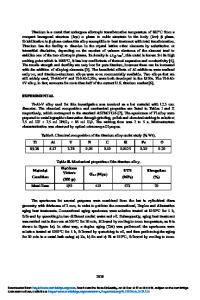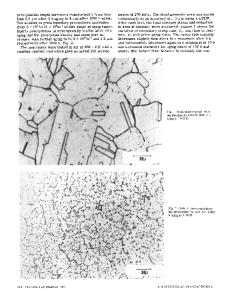A Study on the Effect of Aging on Mechanical Properties of Cold-Formed Non-quenched Steel via Nanoindentation
- PDF / 3,066,142 Bytes
- 6 Pages / 593.972 x 792 pts Page_size
- 54 Downloads / 387 Views
JMEPEG (2017) 26:28–33 DOI: 10.1007/s11665-016-2444-2
A Study on the Effect of Aging on Mechanical Properties of Cold-Formed Non-quenched Steel via Nanoindentation Jinhong Pi, Yunqiang Bai, and Rui Zhen (Submitted March 16, 2016; in revised form November 8, 2016; published online November 28, 2016) The effect of aging on the nanohardness, modulus and creep properties of non-quenched and tempered steel wire strengthened by cold forming to an area reduction of 37% was investigated by nanoindentation. It was found that aging at 300 °C can improve the nanohardness, modulus, wear resistance and creep resistance of the cold-drawn non-quenched and tempered steel. An aging time longer than 2 h is not necessary since the degree of improvement decreases. The creep procedure of all tested samples includes two distinct stages, the transient creep and steady-state creep. Aging treatment slows down the creep rate at the steady-state stage. Keywords
aging, creep, hardness, modulus, nanoindentation, non-quenched and tempered steel
1. Introduction Non-quenched and tempered steel is acquired by adulterating medium-carbon steel with microelements (V, Ti, Nb, N, etc.) and processed by temperature-controlled forging and cooling to precipitate the strengthening phase of carbide or nitride, dispersed from ferrite and pearlite without quenching and tempering (Ref 1, 2). Its mechanical capability is equivalent to that of quenched and tempered carbon structural steel or structural alloy steel (Ref 2). Since the cancelation of two costing heat treatment processes (i.e., quenching and tempering), non-quenched and tempered steel fasteners strengthened by cold deformation (i.e., dislocation strengthening) and grain refinement result from the micro-alloying additions can save energy and cost and decrease waste in the manufacturing (Ref 3). One of the typical applications of this kind of steel is fasteners, which are widely used in the automotive industry. The typical processes of manufacturing fasteners include firstly wire cold drawing, then head upsetting and screw rolling and finally aging at an elevated temperature (Ref 4). It is well known that grains refined by cold plastic deformation, which result in deformation strengthening, are in non-equilibrium condition with a high density of dislocations, which can be altered by a subsequent recovery treatment (Ref 4, 5). Furthermore, fine carbide or nitride particles precipitate dispersedly during aging process, resulting in further dispersion strengthening. It is well known that the failure of fasteners mainly results from fracture, fatigue and abrasion. Additionally, creep and stress relaxation is also important for automobile
Jinhong Pi, Yunqiang Bai, and Rui Zhen, Jiangsu Key Laboratory of Advanced Structural Materials and Application Technology, Nanjing 211167, China; and School of Materials Engineering, Nanjing Institute of Technology, Nanjing 211167, China. Contact e-mail: [email protected].
28—Volume 26(1) January 2017
fasteners manufactured by non-quenched and tempered steels. And attent
Data Loading...











